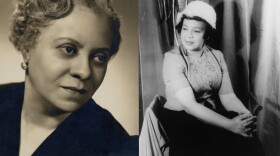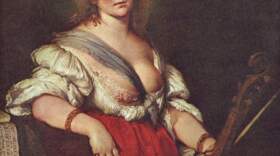-
You’ve heard so much about the sons of Johann Sebastian Bach, but there were daughters, too.Bach was 23, and his wife Maria Barbara was 24, when the first of their children was born. They named her Catherina Dorothea. CD grew into a singer, and helped out in her father’s music work. Fifteen years passed, her mother died, her father remarried, and finally, CD Bach acquired a sister: Cristina Sophia Henrietta, daughter of Johann Sebastian and Anna Magdalena Bach. CSH died at the age of three, just as another sister, Elizabeth Juliana Frederica, was born. EJF Bach would grow up to marry one of her father’s students.
-
Twenty-five years ago, Angèle Dubeau had a thriving career as a concert violinist, having studied with the legendary Dorothy DeLay at the Juilliard School in New York. She had become a popular broadcaster at home in Québec, where she hosted a weekly French-language program on CBC. She already had her Arthur (as she calls her prized Stradivarius violin), but she envisioned an all-Canadian, all-female ensemble.
-
Nettie Asberry opened many doors in her lifetime, including her own. Her teaching and her activism left an indelible mark on the Northwest.
-
The early 20th century presented a series of uphill battles for women in music. For woman of color, they scaled mountains to compose, play and share their voices. It was a series of old locked doors, blatant racism and intolerance. While many in the white, male-dominated music community turned backs, refusing to listen, or even attempted to stop them before they could start , Florence Price and her student Margaret Bonds supported *each other* in tearing down doors and making history.
-
Helen, Countess of Rador seemed to care very little for what society said she could or couldn’t do as a Victorian Lady - so she decided to make history. Born in a tiny town in Central England, a young Helen moved to London, moved to London, married an Earl, and started her [new] life as a countess and patron of the arts.
-
The conductor Mary Terey-Smith made music history here in the Pacific Northwest, as a result of a political revolution half a world away. This Hungarian-born music talent, student of Kodaly at the legendary Franz Liszt Academy in Budapest, hadn’t been out in the working world very long when the 1956 Hungarian Revolution turned her into a refugee.
-
Barbara Strozzi changed the face of vocal music with her stunning and emotional song collections. Born to a famous poet and librettist, she was encouraged to follow her artistic talents from an early age and received a musical education from other famous Italian composers. Strozzi wasn’t afraid to experiment. She made a big name herself in the 17th century, writing songs for sopranos and mezzos, and collections of non religious music; songs and texts that have lived for 400 years.
-
Lara Downes will release a mini-album every month, for as long as she can keep it up, to highlight overlooked and forgotten compositions by Black artists in the classical music tradition. In honor of Women's History Month, its latest entry focuses on some overlooked and under-appreciated bodies of work by women composers and performers.
-
La Maestra, held in Paris this September, is the first fully realized competition solely for women conductors — an effort to help balance a male-dominated field.
-
Dolly Parton, Carla Thomas, Fanny, The Runaways and Salt n Pepa are just some of the women who should be in the Hall by now.
Play Live Radio
Next Up:
0:00
0:00
Available On Air Stations










